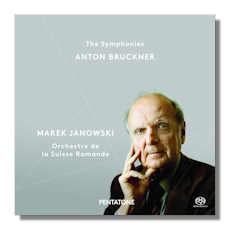
The Internet's Premier Classical Music Source
Related Links
- Bruckner Reviews
- Latest Reviews
- More Reviews
-
By Composer
-
Collections
DVD & Blu-ray
Books
Concert Reviews
Articles/Interviews
Software
Audio
Search Amazon
Recommended Links
Site News
 SACD Review
SACD Review
Anton Bruckner

The Symphonies
- Symphony #1 (1866, Nowak)
- Symphony #2 (1877, Carragan)
- Symphony #3 (1889, Nowak)
- Symphony #4 (1878-1890, Nowak)
- Symphony #5 (1875-1878, Nowak)
- Symphony #6 (1879-1881, Nowak)
- Symphony #7 (1881-1883, Nowak)
- Symphony #8 (1890, Nowak)
- Symphony #9 (Nowak)
- Mass #3 in F minor (1867-1893) *
* Lenneke Ruiten, soprano
* Iris Vermillion, mezzo-soprano
* Shawn Mathey, tenor
* Franz Josef Selig, bass
Orchestre de la Suisse Romande/Marek Janowski
Pentatone 12686 10SACDs Hybrid Multichannel
This is an unusual Bruckner cycle in a couple of respects. First, the performances all appear to be studio-recorded, bucking the trend for live performances of Bruckner symphonies. In fact, the ten discs are not just hybrid SACDs but also offer stereo and multichannel options. Pentatone have clearly made a very significant investment in Janowski's Bruckner cycle, even though (and this is the second unusual feature) the Orchestre de la Suisse Romande was hardly known as a Bruckner orchestra when the cycle began with #9, released in January 2008. Based in Geneva, the Orchestre de la Suisse Romande was led for nearly fifty years by Ernest Ansermet and is much more closely associated with the twentieth-century French and Russian repertoire. As with almost every Bruckner cycle there is some unevenness, but Janowki and the Orchestre de la Suisse Romande repay the confidence shown in them.
Janowski is relatively conventional in his choice of versions. The liner notes describe #1 was being played in the 1866 Linz version, but it is really the revised Linz version that we have here (not the original one, which has been recorded only by Georg Tintner). #2 is in the 1877 version (although in the Carragan edition, rather than the more frequently recorded Nowak and Haas versions). The original 1873 version of #3 is being increasingly heard, but Janowski plays the more familiar 1889 version. Likewise in #4, where he sticks with the 1878-1880 Nowak edition, rather than returning to the original. Nos. 5-7 were not as extensively revised as the other symphonies. In #8 Janowski performs the 1890 version – unlike, say, Simone Young whose recent recording follows the original 1887 version. There has been increasing interest in recording #9 with a "recomposed" finale. Janowski prefers the familiar (unfinished) three movement symphony that Bruckner actually left us. Thankfully!
All this is to say that Janowski's cycle has to sell itself on the quality of the music-making. There is no "novelty factor" in the versions he plays. And nor does Janowski have any major ideological problems with dominant trends in Bruckner performance, in the manner of, for example, Mario Venzago. That may be no bad thing, however (see my reviews of Venzago's #8 on CPO 777691-2 and #5 on CPO 777616-2).
Janowski and the Orchestre de la Suisse Romande do have a distinctive voice in Bruckner. The performances here typically reveal brisk and steady tempi. This can be refreshing. The Andante of #4 is a good example. Here Janowski respects the "quasi allegretto" designation and highlights the dance elements over the solemnities (or at least – these are the ones that make the greatest impression). Similarly in the Adagio of #3, which Bruckner qualifies as "quasi andante".
Where Janowski is less strong is when Bruckner is weaving together very disparate thematic material. In the first movement of #5, for example, the momentum and the architecture are all there, but he doesn't quite succeed in bringing out the individuality of the three principal thematic threads. He does this much more successfully in the last movement of #5 where he has the help of Bruckner's strict counterpoint. And the movements that are more thematically homogenous, as it were, are where Janowski really shines. Listening to the Adagio of #8 it is hard not to think that this is where conductor and orchestra feel most at home. The slow movements certainly suit the strengths of the Orchestre de la Suisse Romande's fine string section.
There are some very strong performances here. I particularly appreciated the first two symphonies and the last two (No. 8 and #9). Janowski makes a good case for Nos. 1 and 2, with particular success in the slow movements. The finale of #8 is dramatic and intense, and the first movement has a sense of urgency that is lacking from some of the middle symphonies. We get an old school interpretation of #9, with the Adagio definitely played as a finale. Both of these two very complex symphonies are well-paced throughout and Janowski communicates a clear sense of structure through Bruckner's waves of sound. I personally found Nos. 4 and 7 a little disappointing (perhaps this is because they are Bruckner's most recorded symphonies and so something really special is needed to stand out). The finale of #4 was curiously unsatisfying and both performances suffer from a degree of "flatness" – the peaks are lower and the troughs less deep than at the hands of a Wand or a Thielemann, for example.
Overall the sound quality is excellent (I listened in SACD stereo). The orchestration emerges with great clarity and the Orchestre de la Suisse Romande's strings sound rich and luscious. The very attractively packaged box includes a bonus disc of the Mass in F minor (which, particularly in the Benedictus and the Agnus Dei, sounds rather more symphonic than liturgical). The liner notes are intelligent (although sadly not as detailed as on the discs issued separately). And, as another pleasant bonus, Pentatone have included a voucher for a free download at their website. Despite some reservations this set is recommended, particularly to anyone wanting an audiophile Bruckner cycle.
Copyright © 2015, José Luis Bermúdez





















